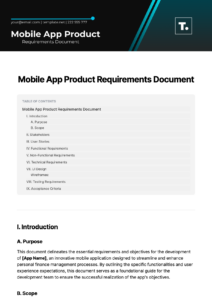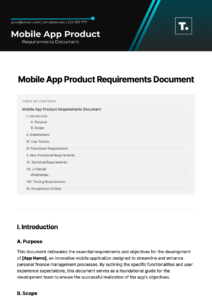Creating a successful mobile application requires careful planning and documentation. One essential tool that can streamline this process is an app development requirements template. This template provides a structured framework for capturing the essential details and specifications of your app, ensuring that all stakeholders are on the same page and working towards a common goal.
An app development requirements template typically includes sections for:
- Project overview
- User stories
- Functional requirements
- Non-functional requirements
- Acceptance criteria
By using a requirements template, you can ensure that all the critical information is captured and organized in a consistent manner. This makes it easier to communicate the project’s scope, objectives, and constraints to everyone involved, including developers, designers, testers, and stakeholders.
Essential Components of an App Development Requirements Template
The following sections delve into the key components of an effective app development requirements template:
Project Overview: This section provides a summary of the project’s goals, objectives, and scope. It should clearly state the business problem that the app aims to solve and the target audience for the application.
User Stories: User stories are brief narratives that describe how users will interact with the app. They should be written from the perspective of the user and focus on the user’s needs and objectives. User stories help developers understand the app’s functionality from a user-centric perspective.
Functional Requirements: These requirements define the specific features and functionalities of the app. They should include a detailed description of how the app will work, including any input and output requirements. Functional requirements ensure that the app meets the intended user needs.
Non-Functional Requirements: These requirements focus on the performance, security, and other qualitative attributes of the app. They may include requirements related to responsiveness, scalability, reliability, and data privacy.
Acceptance Criteria: Acceptance criteria define the conditions that must be met for the app to be considered complete and successful. They should be specific, measurable, achievable, relevant, and time-bound (SMART) to ensure that the app meets the project’s objectives.
Benefits of Using an App Development Requirements Template
There are numerous benefits to using an app development requirements template, including:
- Improved communication and collaboration among project stakeholders
- Reduced risk of misinterpretation or misunderstandings
- Faster development cycles and reduced time to market
- Higher quality apps that meet user needs
- Easier maintenance and updates
By following a structured and standardized approach, an app development requirements template helps teams streamline the app development process, reduce errors, and deliver successful mobile applications that meet the intended goals and objectives.
Conclusion
An app development requirements template is an indispensable tool for any mobile app development project. It provides a clear and comprehensive framework for capturing and documenting the essential details of the app, ensuring that all stakeholders have a shared understanding of the project’s scope, objectives, and constraints.
By using an app development requirements template, teams can improve communication and collaboration, reduce the risk of errors, and deliver high-quality apps that meet user needs. The time and effort invested in creating a detailed and well-structured requirements template will ultimately pay dividends throughout the development process and beyond.

